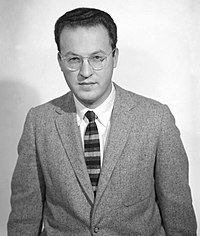Donald Arthur Glaser
Donald Arthur Glaser (born September 21, 1926 in Cleveland , Ohio , † February 28, 2013 in Berkeley , California ) was an American physicist, molecular biologist, neurobiologist and Nobel Prize winner .
Life
Donald Arthur Glaser was born on September 21, 1926 as the son of businessman William J. Glaser and his wife Lena Glaser in Cleveland / Ohio. After attending public schools in Cleveland Heights , he studied physics and mathematics at the Case Institute of Technology . After his BS in 1946, he taught for one semester at the Case Institute of Technology. He went in the autumn of the year at the California Institute of Technology and received his doctorate there in 1950 in mathematics and physics.
In 1949 he received a lecturer position at the physics faculty at the University of Michigan and was appointed professor in 1957, and in 1959 he moved to the University of California, Berkeley . In 1962 he was elected to the National Academy of Sciences , 1997 to the American Philosophical Society and 2003 to the American Academy of Arts and Sciences .
Glaser married Ruth Bonnie Thompson in 1960, with whom he had two children: the pediatrician Louise Ferris Addison and the CEO of a computer company, William Thompson Glaser. In 1975 he married the painter Lynn Bercovitz.
plant
Glaser's research focus in his early years was in the area of elementary particle physics, with an interest in the experimental techniques that might be helpful in this area. He constructed several diffusion cloud chambers and spark counters and developed the ideas that resulted in the invention of the bubble chamber in 1952 . In the following years he developed other types of bubble chambers for experiments in high-energy physics and also carried out experiments himself at the Cosmotrom of the Brookhaven National Laboratory in New York and the Bevatron of the Lawrence Radiation Laboratory in California . In 1960 he was awarded the Nobel Prize in Physics for " inventing the bubble chamber " .
In 1962, Glaser turned to the field of molecular biology, which had been of interest to him since his studies at CalTech. After the foundations of modern biotechnology had been laid through the knowledge that the DNA and RNA of microorganisms are structured in the same way as those of more highly developed living beings, Glaser and his students investigated the control mechanisms of DNA synthesis in bacteria. He was also able to use mutated Chinese hamster egg cells to demonstrate an increased sensitivity to ultraviolet light, which enabled these cells to turn into cancer cells . The seven genes involved in this process are also found in humans, with the same defects leading to the cancer " Xeroderma pigmentosum ".
When Glaser discovered around 1970 that molecular biology provided a very detailed knowledge, but that was hardly applied in medicine or other areas, he founded the first biotechnology company with two friends and thus founded this branch of industry that had a major impact on medicine and Agriculture has.
Since the experimental effort for biochemical and molecular technologies increased very quickly due to this industrialization of biotechnology, he turned again to another area - neurobiology, especially the human visual system. This is one of the best-studied areas of the human brain, and its "circuit diagram" is very well understood. Based on computer models of human vision, predictions can be made about the visual abilities of humans and monkeys, which can be checked using psychophysical and electrophysical methods. These models have already led to descriptions of the perception of movement and depth and led to the prediction of two new effects of deception with regard to movement, which are currently being examined by Glaser's research group on humans and monkeys.
Awards
- Henry Russell Prize, University of Michigan, 1953
- Charles Vernon Boys Prize, Physical Society, 1958
- American Physical Society Prize, 1959
- Nobel Prize in Physics , 1960
literature
- Tomaso Poggio : Donald Arthur Glaser (1926-2013). Physicist and Biotechnologist who Invented the Bubble Chamber. In: Nature . Volume 496, No. 7443, p. 32, 2013, doi: 10.1038 / 496032a
- Donald A. Glaser , in: Internationales Biographisches Archiv 32/2001 of July 30, 2001, in the Munzinger archive ( beginning of article freely accessible)
Web links
- Information from the Nobel Foundation on the 1960 award ceremony for Donald A. Glaser (English)
- Donald Glaser
Individual evidence
- ↑ Physics Nobelist and biotech pioneer Donald Glaser this at 86
- ↑ Member History: Donald A. Glaser. American Philosophical Society, accessed August 21, 2018 .
| personal data | |
|---|---|
| SURNAME | Glaser, Donald Arthur |
| BRIEF DESCRIPTION | American physicist, molecular biologist, neurobiologist and Nobel Prize winner |
| DATE OF BIRTH | September 21, 1926 |
| PLACE OF BIRTH | Cleveland , Ohio |
| DATE OF DEATH | February 28, 2013 |
| Place of death | Berkeley , California |
